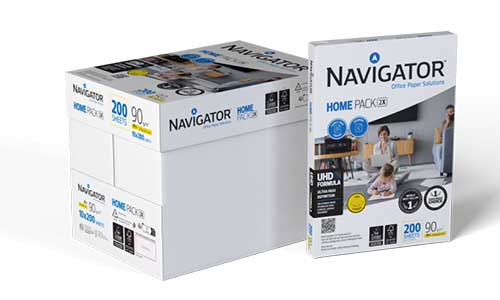
Navigator launches Home Pack 2X: a pack for the entire family, redefining Home Paper Solutions – A pack that multiplies the possibilities for both work and play within your family, at home
Navigator has extended its Home Pack range with the recent launch of Navigator Home Pack 2X. This new pack with 200 sheets of 90 g.m-2 was designed to fulfil 2 main applications: double side printing and drawing/crafting, enhancing efficiency and reducing environmental impact. Indeed, the top-quality double-sided printing capabilities of this thicker paper, allows users to save of up to 50% on paper, by using both sides of the sheet, while enjoying vibrant prints and impressive colour contrasts, thanks to its UHD Formula; at the same time it is the perfect paper for children’s artworks.
Navigator Home Pack 2X offers unparalleled versatility, empowering adults and children, to explore endless possibilities. For families seeking inspiration for their creative projects, Navigator Home Pack 2X offers the solution: each pack includes a QR code that leads to a dedicated landing page featuring a variety of activities, starting with a sheet of Navigator paper: from crafting paper plane races to creating paper trees.
Navigator Home Pack 2X adds to the existing Navigator Home Pack – a 80 g.m-2 pack with 250 sheets – and Navigator Home Pack XS – a pack with 150 sheets of 80 g.m-2 – both tailored to meet the needs of households, particularly in an era of widespread teleworking.
Paper is here to stay, and Navigator paper is here for you, being part of people’s lives across multiple generations, throughout various stages of life.
Navigator is a global paper brand, present in more than 130 countries, produced by The Navigator Company, one of the first companies worldwide to officially commit to be Carbon Neutrality by 2035. The company is also committed to an 86% reduction in direct CO2 emissions compared to 2018. Furthermore, by 2030, 80% of its primary energy consumption will be sourced from renewables and by 2035 100% of the electricity will have that origin.

































